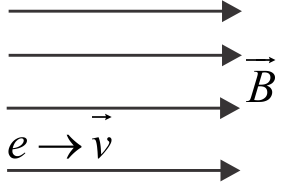362727
A proton moving with a constant velocity passes through a region of space without any change in its velocity. If \(\vec{E}\) and \(\vec{B}\) represent the electric and magnetic fields respectively, then the region of space may have :
\(({\rm{A}}){\mkern 1mu} {\mkern 1mu} {\mkern 1mu} E = 0,B = 0\,\,\,\,\,\,\,({\rm{B}}){\mkern 1mu} {\mkern 1mu} \,E = 0,B \ne 0\)
\(({\rm{C}}){\mkern 1mu} {\mkern 1mu} {\mkern 1mu} E \ne 0,B = 0{\rm{ }}\,\,\,\,\,\,\,({\rm{D}}){\mkern 1mu} {\mkern 1mu} {\mkern 1mu} E \ne 0,B \ne 0{\rm{ }}\)
362727
A proton moving with a constant velocity passes through a region of space without any change in its velocity. If \(\vec{E}\) and \(\vec{B}\) represent the electric and magnetic fields respectively, then the region of space may have :
\(({\rm{A}}){\mkern 1mu} {\mkern 1mu} {\mkern 1mu} E = 0,B = 0\,\,\,\,\,\,\,({\rm{B}}){\mkern 1mu} {\mkern 1mu} \,E = 0,B \ne 0\)
\(({\rm{C}}){\mkern 1mu} {\mkern 1mu} {\mkern 1mu} E \ne 0,B = 0{\rm{ }}\,\,\,\,\,\,\,({\rm{D}}){\mkern 1mu} {\mkern 1mu} {\mkern 1mu} E \ne 0,B \ne 0{\rm{ }}\)
362727
A proton moving with a constant velocity passes through a region of space without any change in its velocity. If \(\vec{E}\) and \(\vec{B}\) represent the electric and magnetic fields respectively, then the region of space may have :
\(({\rm{A}}){\mkern 1mu} {\mkern 1mu} {\mkern 1mu} E = 0,B = 0\,\,\,\,\,\,\,({\rm{B}}){\mkern 1mu} {\mkern 1mu} \,E = 0,B \ne 0\)
\(({\rm{C}}){\mkern 1mu} {\mkern 1mu} {\mkern 1mu} E \ne 0,B = 0{\rm{ }}\,\,\,\,\,\,\,({\rm{D}}){\mkern 1mu} {\mkern 1mu} {\mkern 1mu} E \ne 0,B \ne 0{\rm{ }}\)
362727
A proton moving with a constant velocity passes through a region of space without any change in its velocity. If \(\vec{E}\) and \(\vec{B}\) represent the electric and magnetic fields respectively, then the region of space may have :
\(({\rm{A}}){\mkern 1mu} {\mkern 1mu} {\mkern 1mu} E = 0,B = 0\,\,\,\,\,\,\,({\rm{B}}){\mkern 1mu} {\mkern 1mu} \,E = 0,B \ne 0\)
\(({\rm{C}}){\mkern 1mu} {\mkern 1mu} {\mkern 1mu} E \ne 0,B = 0{\rm{ }}\,\,\,\,\,\,\,({\rm{D}}){\mkern 1mu} {\mkern 1mu} {\mkern 1mu} E \ne 0,B \ne 0{\rm{ }}\)
362727
A proton moving with a constant velocity passes through a region of space without any change in its velocity. If \(\vec{E}\) and \(\vec{B}\) represent the electric and magnetic fields respectively, then the region of space may have :
\(({\rm{A}}){\mkern 1mu} {\mkern 1mu} {\mkern 1mu} E = 0,B = 0\,\,\,\,\,\,\,({\rm{B}}){\mkern 1mu} {\mkern 1mu} \,E = 0,B \ne 0\)
\(({\rm{C}}){\mkern 1mu} {\mkern 1mu} {\mkern 1mu} E \ne 0,B = 0{\rm{ }}\,\,\,\,\,\,\,({\rm{D}}){\mkern 1mu} {\mkern 1mu} {\mkern 1mu} E \ne 0,B \ne 0{\rm{ }}\)

